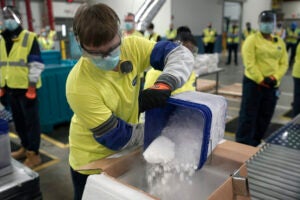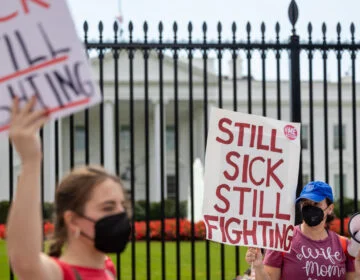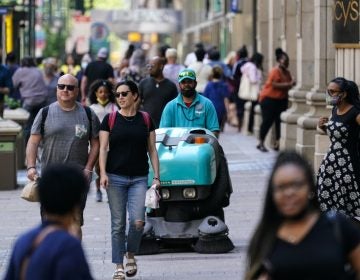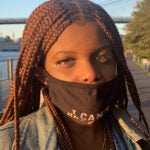Double masking offers more virus protection, a CDC study suggests
The Centers for Disease Control and Prevention cited experiments done with lab dummies. Dr. Fauci has been touting double masking for weeks.
Listen 1:14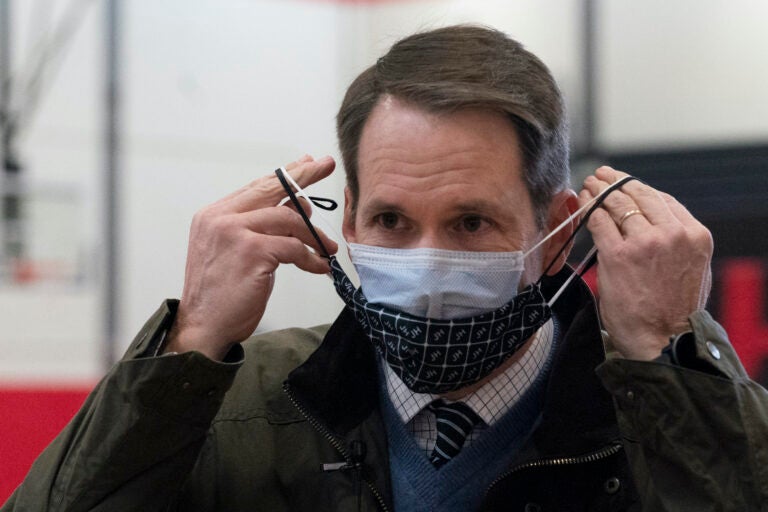
Congressman Jim Himes, D-Conn., adjusts his two masks during a tour of a vaccination clinic, Wednesday, Feb. 10, 2021, at Central High School in Bridgeport, Conn. (AP Photo/Mark Lennihan)
Ask us about COVID-19: What questions do you have about the current surge?
With no end to the pandemic in sight and variants of the coronavirus spreading across the country, wearing just one mask when you leave the house may not be enough. Dr. Anthony Fauci, the well-known face of the National Institute of Allergy and Infectious Diseases, often wears two masks, and now the Centers for Disease Control and Prevention also suggests double-masking offers better protection.
“This is physical covering to prevent droplets and virus to get in, so if you have a physical covering with one layer, you put another layer on, it just makes common sense that it likely would be more effective,” Fauci told NBC’s “Today” show last month.
At first, however, not all health professionals viewed it as a commonsense approach. Joseph Amon, a clinical professor and director of the Office of Global Health at Drexel University’s Dornsife School of Public Health, expressed his own doubts about it.
“It’s important to remember that the kind of core principles are still very much in effect. Double masking isn’t going to be the solution to keeping people protected from COVID,” Amon said. “We need to remember that the risks are highest in closed spaces amongst crowds in close contact, and we need to maintain our vigilance with physical distancing and being cautious.”
Amon argued that although double masking can improve fit, it can also make it harder for people to breathe, causing them to have to breathe more forcefully, which can draw more air through masks or around masks that can bring in viruses.
According to research cited by the CDC Wednesday, lab tests conducted with dummies showed exposure to potentially infectious aerosols decreased by 95% when the dummies wore tightly fitted masks — including a cloth mask over a medical procedure mask.
The researchers also suggested tying knots along the earlobes of medical masks for better protection.
Jenn Faynberg, a social media manager and Temple University alumna, said she’s been wearing two masks for the past couple of weeks.
“I’ve been seeing a lot of headlines recently saying double or even triple masking is more effective in terms of protection against the spread of COVID-19,” Faynberg said.” To me it really isn’t an inconvenience or any harder to do than wearing one mask.”
Even before the CDC announced that double-masking offered more protection in its experiments, Faynberg didn’t want to take any risks.
“If there’s evidence that wearing two or more masks is more effective at preventing the spread of COVID, we should absolutely be doing it,” Faynberg said. “Especially considering how quickly the number of COVID deaths in the U.S. has grown in just the last few months.”
According to the CDC, roughly 34 states have reported the variant strain of SARS-CoV-2 known as B.1.1.7 that was identified in the United Kingdom. And although the total number of hospitalizations has gone down recently, there have still been more than 27.1 million total COVID-19 cases reported in the United States, with over 109,000 cases in Philadelphia alone.
“There will continue to be new variants that are found that will also circulate, so we’re in a race to get vaccinated, we’re in a race to protect ourselves …” Amon said.
Monica Gandhi, a physician specializing in infectious diseases and HIV at the University of California San Francisco, published a commentary on the types of masks that are most effective. On Twitter, Gandhi warned against layering with more than two masks, but she recommended either an N95 or a surgical mask plus cloth mask combo, versus one cloth mask with a filter in between two layers for medically vulnerable people.
By surgical mask, she was referring to the light blue masks you can buy at your local store.
Although health officials agree the N95 mask is the gold standard, they don’t recommend the public wear them — those masks should be reserved for first responders and health care workers.
Before the recent announcement from the CDC, there hadn’t been enough clarification regarding what types of masks people should be wearing, Gandhi said.
“It gives people some gravitas to all the circulating reports of double masking for the CDC to mention it,” Gandhi said. “And there’s no doubt that tamping down transmission will help our vaccines work better.”

Get daily updates from WHYY News!
WHYY is your source for fact-based, in-depth journalism and information. As a nonprofit organization, we rely on financial support from readers like you. Please give today.



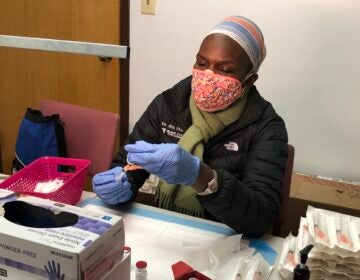
![CoronavirusPandemic_1024x512[1]](https://whyy.org/wp-content/uploads/2020/03/CoronavirusPandemic_1024x5121-300x150.jpg)
